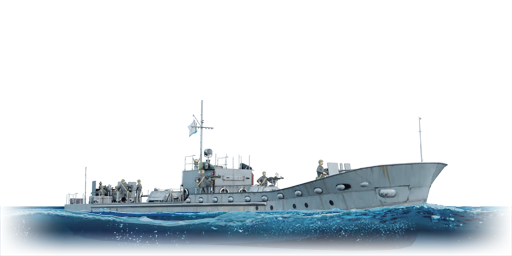

Coastal Fleet
MBK-161 late
IV
Rank
AB
3.7
RB
3.7
Battle rating
USSR
Game nation
Heavy boat
Main role
120,000

Research
360,000

Purchase
General information
Specification
Armour
Citadel
30 / 52 / 18 mm
Main fire tower
53 / 53 / 53 mm
Hull
5 mm (steel)
Superstructure
4 mm (steel)
Number of sections
4
Displacement
163 t
Crew
39 persons
Max speed
Forward
25223425 km/h
Backward
98139 km/h
Primary armament
2 × Turret — 76 mm/40 F-34 cannon
Ammunition
384 rounds
Reload
basic crew → aces
5 → 3.8 s
Vertical guidance
-5 / 25°
Turret Rotation Speed
Horizontal
2521.32521.3 °/s
Vertical
43.443.4 °/s
| Ammunition | Type | Armor penetration (mm) at a distance: | |||||
|---|---|---|---|---|---|---|---|
| 100 m | 1000 m | 2000 m | 3000 m | 4000 m | 5000 m | ||
| HE | 10 | 10 | 10 | 10 | 10 | 10 | |
| APHEBC | 85 | 72 | 62 | 55 | 49 | 45 | |
Secondary armament
2 × Turret — 45 mm/68 21-KM cannon
Ammunition
1,000 rounds
Reload
basic crew → aces
2.6 → 2 s
Vertical guidance
-5 / 85°
Turret Rotation Speed
Horizontal
1512.81512.8 °/s
Vertical
1512.81512.8 °/s
| Ammunition | Type | Armor penetration (mm) at a distance: | |||||
|---|---|---|---|---|---|---|---|
| 100 m | 1000 m | 2000 m | 3000 m | 4000 m | 5000 m | ||
| HE | 8 | 6 | 5 | 5 | 5 | 5 | |
| HE | 5 | 5 | 5 | 5 | 5 | 5 | |
| APHE | 86 | 67 | 54 | 46 | 41 | 37 | |
| HE | 23 | 18 | 15 | 13 | 11 | 10 | |
Anti-aircraft armament
37 mm/67 70-K automatic cannon
Ammunition
2,000 rounds
Belt capacity
5 rounds
Reload
basic crew → aces
0.4 → 0.3 s
Fire rate
180 shots/min
Vertical guidance
-5 / 85°
Turret Rotation Speed
Horizontal
19.616.719.616.7 °/s
Vertical
1512.81512.8 °/s
| Belt | Belt filling | Armor penetration (mm) at a distance: | |||||
|---|---|---|---|---|---|---|---|
| 10 m | 100 m | 500 m | 1000 m | 1500 m | 2000 m | ||
| HEF-T/AP-T/HEF-T/HEF-T/AP-T | 79 | 76 | 65 | 56 | 49 | 44 | |
2 × Turret — 12.7 mm DShK machine gun
Ammunition
4,000 rounds
Belt capacity
50 rounds
Reload
basic crew → aces
5.2 → 4 s
Fire rate
600 shots/min
Vertical guidance
-5 / 55°
Turret Rotation Speed
Horizontal
7563.87563.8 °/s
Vertical
6555.36555.3 °/s
| Belt | Belt filling | Armor penetration (mm) at a distance: | |||||
|---|---|---|---|---|---|---|---|
| 10 m | 100 m | 500 m | 1000 m | 1500 m | 2000 m | ||
| AP-I/API-T/AP-I/IAI | 30 | 29 | 26 | 23 | 20 | 19 | |
Economy
Repair cost
Basic → Reference
AB
3,653 → 4,592 

RB
4,541 → 5,708 

Crew training
105,000 

Experts
360,000 

Aces
1,200 

Research Aces
570,000 

Reward multiplier
AB / RB
120 / 200 % 

178 % 

Total cost of modifications
166,400 

275,000 

Talisman cost
1,800 

Research order:
Seakeeping |
|---|
Unsinkability | |
|---|---|
Firepower | ||
|---|---|---|
Rating by players
You must play more than 3 battles for the last week and more than 10 battles in a vehicle to rate it.
Like:
3
Armor protection:
Not enough ratings
Survivability:
Not enough ratings
Mobility:
Not enough ratings
Armament:
Not enough ratings
Balance:
Not enough ratings
Tips & Tricks
This space is currently empty
Do you know any interesting vehicle features?
Loading...
No articles about this vehicle yet
Become the first author and get rewards!
Write a guide, tell about interesting historical facts, make a tutorial or simply an interesting post.
No more content